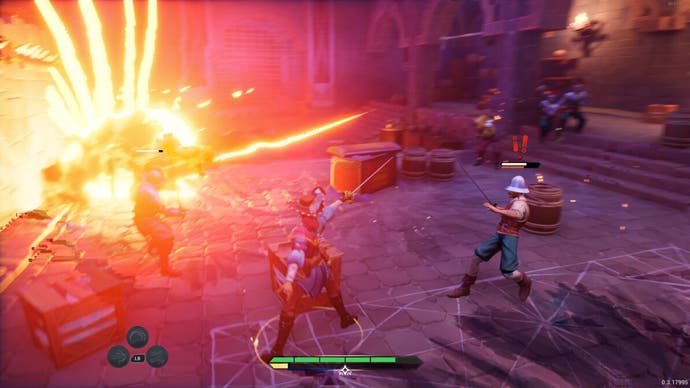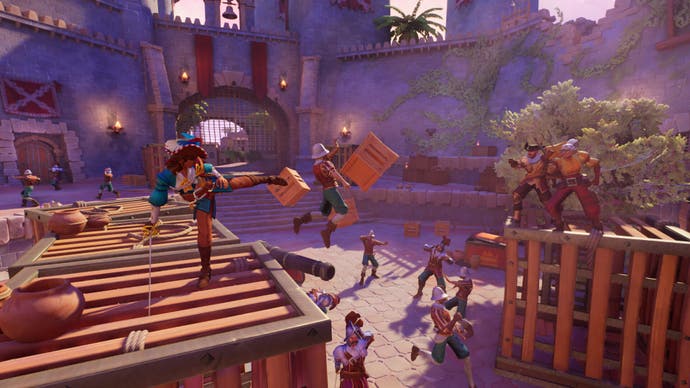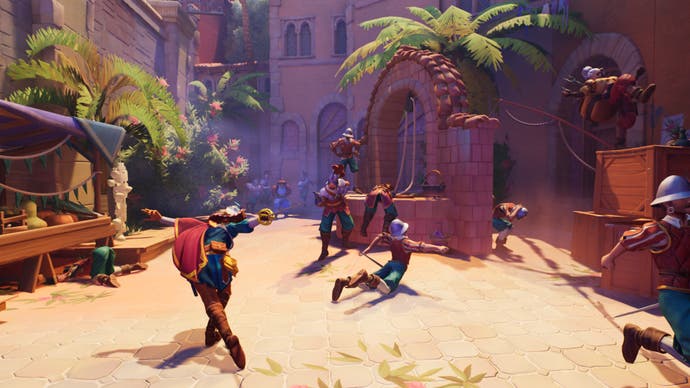En Garde! review - swashbuckling charm erupts in every direction
Cannon event.
Gaspar de Guzmán y Pimentel, 1st Duke of Sanlúcar, 3rd Count of Olivares, known to history as the Count-Duke of Olivares, is one of those historical figures who really deserves a video game made them. Not a video game that sees them as the hero, of course, but as the terrifying, grasping, mercurial villain. The Count-Duke was the favourite of Spain's Philip IV. In paintings from the era he fairly radiates malice and self-interest. He was huge and powerful, the epitome of the power behind the throne.
And I'm pretty sure he's the model for the villain in En Garde!, a spry and witty swashbuckling game set in Spain's golden age. The Count-Duke is everywhere in this game, even when he isn't dominating boss fights: he glowers from the walls in paintings that reference works of Velazquez and - at one point - El Greco. His scheming notes are scattered around waiting to be found. He's planning something - something big and terrible. Like the real Count-Duke in the court of Philip IV, his presence in this world is inescapable.
Fans of Spanish history will enjoy stuff like this, I think, but the delights of En Garde! are so generous, so freewheeling that there's something for everyone. This is a third-person action game with a brilliant heroine, brisk, breezy platforming and rapier combat inspired by the likes of the Arkham games. It's a colourful journey across a bunch of lovely, intricate maps. It's a bit of a treat in every way.
Let's look at the platforming first. It's made of simple bits and pieces - bar swings, mantling, bounce-pads, ropes - but it's handled with confidence and quick restarts for moments where you miss a jump. Playing as a swashbuckler, it was inevitable that you'd end up bouncing around the place, scaling the outside walls of villas and churches, rushing along battlements and hopping over the covered stalls of market squares. All of this allows En Garde! to bend its simple action-adventure agenda into lovely wriggly shapes. Some of my happiest moments here involve simply dancing through platforming gauntlets from one battle to the next, storming a country house at night in one moment, working my way up towards the promise of a lighted window shining out against the night sky, only to pick a path through a garden maze the next.
The platforming breaks up the main event here, which is sword-fighting, generally against groups of enemies with different skills. It's a counter-heavy game: even against the simplest foes you wait for the signal that an attack is coming, parry it, and then exploit the opening. Crowd management is the real challenge; rushing in swinging is almost never a good idea from the off.


But it's not all parrying. As the enemies evolve, so do your abilities. There's a kick that you can perform on stunned enemies to send them reeling and hopefully break their guard. There are special attacks that you can earn the juice for by countering and striking with elegance. And as the enemies scale - multiple hit points, shields, attacks that cannot be parried - so do your environmental options.
Here is where combat sings, in fact. From buckets to throw onto enemy's heads to metal tea sets to lamp them with, crates to kick into them, billiard tables to flip into their path, each arena will have a handful of elements you can turn to your advantage when you want to stun a foe, or even a group of foes, in order to make a bit of space. Late in the game you can bring chandeliers down on enemies, which is basically swashbuckling 101, but even before that there are lovely comic chain-reactions to unlock. There's a real Mousetrap-like pleasure to booting someone downstairs, watching them stumble over a crate and fall into a plinth, only to have the vase on top of the plinth fall onto their head.
Bright clouds of spice, grenadiers, later enemies who have almost no obvious openings for attacks, all of this stuff combines in a game that manages to keep combat fresh, and that also serves as a regular reminder that it was heroes like Zorro who were the inspiration for modern superheroes like Batman.

The sheer energy of the game also helps me to forgive a slight fuzziness to the edges. It can be hard in the middle of a battle to make sure I'm attacking the correct foe when so many cluster around me despite a couple of targeting options, and sometimes I'll boot a crate at someone just to have it ping off at someone else in a manner that's less than useful. I also think - and I appreciate this is highly subjective - that En Garde! might be a little too challenging at times. It's not afraid to throw in multi-wave defeat-everyone moments, and bosses, particularly the final boss of the game, can sometimes feel exhausting.
It's worth sticking with it through such moments, though. Painted in Bougainvillea pinks and honeyed golds, with horizons dithering into impressionist brush strokes, this is one of the prettiest and most colourful action games I've encountered in an age, and its cheery spirit never seems to dip. The odd boss fight aside I've loved my time dashing through this world, seeing its sights and finishing off its foes with elegance and poise - or at least enjoying the pratfalls when it all goes wrong. Well played, En Garde! Well played.


